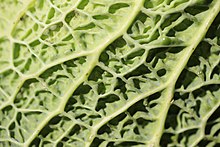| This article needs additional citations for verification. Please help improve this article by adding citations to reliable sources. Unsourced material may be challenged and removed. Find sources: "Savoy cabbage" – news · newspapers · books · scholar · JSTOR (January 2017) (Learn how and when to remove this message) |
 Savoy cabbage Savoy cabbage | |
| Species | Brassica oleracea var. sabauda L. |
|---|---|
| Cultivar group | Brassica oleracea Savoy Cabbage Group |
| Cultivar group members |
|
 | |||||||||||||||||||||||||||||||||||||||||||||||||||||
| Nutritional value per 100 g (3.5 oz) | |||||||||||||||||||||||||||||||||||||||||||||||||||||
|---|---|---|---|---|---|---|---|---|---|---|---|---|---|---|---|---|---|---|---|---|---|---|---|---|---|---|---|---|---|---|---|---|---|---|---|---|---|---|---|---|---|---|---|---|---|---|---|---|---|---|---|---|---|
| Energy | 113 kJ (27 kcal) | ||||||||||||||||||||||||||||||||||||||||||||||||||||
| Carbohydrates | 6.1 g | ||||||||||||||||||||||||||||||||||||||||||||||||||||
| Sugars | 2.27 g | ||||||||||||||||||||||||||||||||||||||||||||||||||||
| Dietary fiber | 3.1 g | ||||||||||||||||||||||||||||||||||||||||||||||||||||
| Fat | 0.1 g | ||||||||||||||||||||||||||||||||||||||||||||||||||||
| Protein | 2 g | ||||||||||||||||||||||||||||||||||||||||||||||||||||
| |||||||||||||||||||||||||||||||||||||||||||||||||||||
| Other constituents | Quantity | ||||||||||||||||||||||||||||||||||||||||||||||||||||
| Water | 91 g | ||||||||||||||||||||||||||||||||||||||||||||||||||||
Link to USDA Database entry | |||||||||||||||||||||||||||||||||||||||||||||||||||||
| Percentages estimated using US recommendations for adults, except for potassium, which is estimated based on expert recommendation from the National Academies. | |||||||||||||||||||||||||||||||||||||||||||||||||||||
Savoy cabbage (Brassica oleracea var. sabauda L. or Brassica oleracea Savoy Cabbage Group) is a variety or cultivar group of the plant species Brassica oleracea. Savoy cabbage is a winter vegetable and one of several cabbage varieties. It has crinkled, emerald green leaves, which are crunchy with a slightly elastic consistency on the palate.
Named after the Savoy region in France, it is also known as Milan cabbage (cavolo di Milano) or Lombard cabbage (cavolo lombardo), after Milan and its Lombardy region in Italy. Known cultivars include 'Savoy King' (in the US), 'Tundra' (green with a firm, round heart) and 'Winter King' (with dark crumpled leaves).
Uses


Savoy cabbage maintains a firm texture when cooked, which is desired in some recipes. Savoy cabbage can be used in a variety of ways. It pairs well with white wine, apples, spices, horseradish and meat. It can be used for roulades, in stews and soups, such as borscht, as well as roasted plain and drizzled with olive oil. It can be used in preserved recipes such as kimchi or sauerkraut, and with strong and unusual seasonings such as juniper.
Signs of desirable quality include cabbage that is heavy for its size with leaves that are unblemished and have a bright, fresh look. Peak season for most cabbages in the Northern Hemisphere runs from November through April.
Fresh whole cabbage will keep in the refrigerator for one to six weeks depending on type and variety. Hard green, white or red cabbages will keep the longest while the looser Savoy and Chinese varieties such as bok choy need to be consumed more quickly. It is necessary to keep the outer leaves intact without washing when storing since moisture hastens decay.
Savoy can be difficult to grow as it is vulnerable to caterpillars, pigeons, and club root disease. It does best in full sun, and is winter-hardy, able to tolerate the cold, frost, and snow.
Nutrition
Raw Savoy cabbage is 91% water, 6% carbohydrates, 2% protein, and contains negligible fat (table). In a reference amount of 100 grams (3.5 oz), it supplies 27 calories, and is a rich source (20% or more of the Daily Value, DV) of vitamin K (66% DV), vitamin C (37% DV), and folate (20% DV), with a moderate amount of vitamin B6 (15% DV). There are no other micronutrients in significant content (table).
See also
- January King cabbage (another winter cabbage)
References
- United States Food and Drug Administration (2024). "Daily Value on the Nutrition and Supplement Facts Labels". FDA. Archived from the original on 2024-03-27. Retrieved 2024-03-28.
- National Academies of Sciences, Engineering, and Medicine; Health and Medicine Division; Food and Nutrition Board; Committee to Review the Dietary Reference Intakes for Sodium and Potassium (2019). "Chapter 4: Potassium: Dietary Reference Intakes for Adequacy". In Oria, Maria; Harrison, Meghan; Stallings, Virginia A. (eds.). Dietary Reference Intakes for Sodium and Potassium. The National Academies Collection: Reports funded by National Institutes of Health. Washington, DC: National Academies Press (US). pp. 120–121. doi:10.17226/25353. ISBN 978-0-309-48834-1. PMID 30844154. Retrieved 2024-12-05.
- "Cabbage (Red Cabbage, Savoy Cabbage, White Cabbage, Sweetheart Cabbage)". thetortoisetable.org.uk. Retrieved 23 January 2017.
- ^ Titmarsh, Alan (2008). The Kitchen Gardener. BBC Books. p. 247.
- ^ Hyman, Clarissa. "Savoy cabbage In Season". foodandtravel.com. Retrieved 23 January 2017.
- ^ "Savoy Cabbage". specialtyproduce.com. Retrieved 23 January 2017.
- "Savoy Cabbage". Retrieved 9 January 2023.
- Henry, Diana (12 December 2010). "Savoy cabbage with juniper recipe". The Telegraph. Retrieved 23 January 2017.
External links
- "Brassica oleracea var. sabauda L." National Center for Biotechnology Information (NCBI).
- Brassica oleracea var. sabauda L., Tropicos.org, Missouri Botanical Garden
![]() Media related to Brassica oleracea var. sabauda at Wikimedia Commons
Media related to Brassica oleracea var. sabauda at Wikimedia Commons
| Brassica oleracea | |
|---|---|
| Brassica oleracea | |
| See also | |